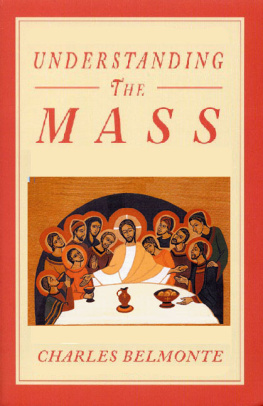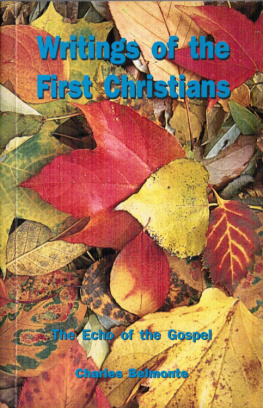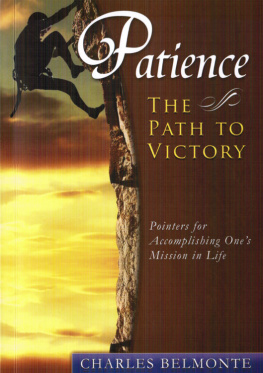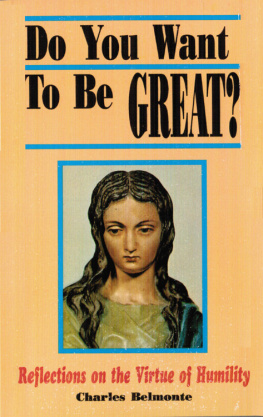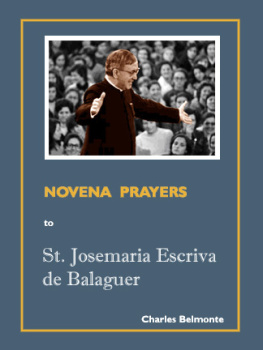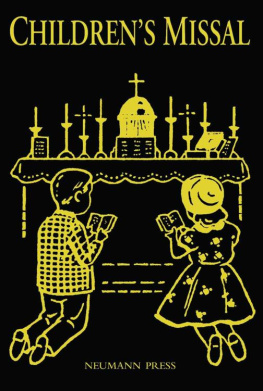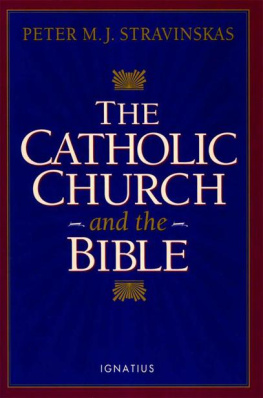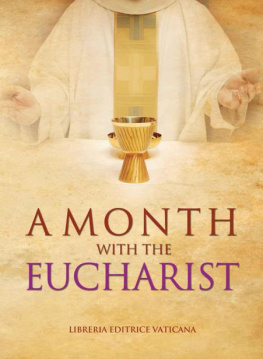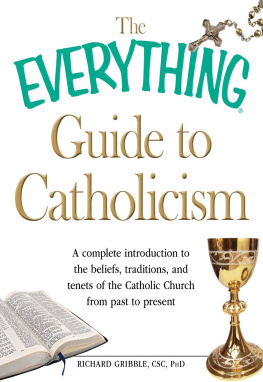UNDERSTANDING THE MASS
CharlesBelmonte
UNDERSTANDING THE MASS
ItsRelevance to Daily Life
CharlesBelmonte
First Edition July1989
Second Edition October1989
Third Filipino edition2009
Fourth EditionDecember 2011
Copyright 2012 by CharlesBelmonte
ISBN 971-117-141-4
NIHIL OBSTAT: Msgr. Josefino Ramirez
VicarGeneral & Censor
IMPRIMATUR: Jaime Cardinal Sin
Archbishop of Manila
The Nihil Obstat and Imprimatur area declaration that a book is considered free from error in matters of Faith andMorals and therefore fit for publication. It is not implied that those who havegranted the Nihil Obstat and Imprimatur agree with the contents,opinions or statement expressed.
Acknowledgments:
Scripturequotations are mostly from the Jerusalem Bible
1969 Darton, Longman and Todd
andDoubleday and Co. Inc.
TABLE OF CONTENTS
I.THIS IS THE MASS
II.INTRODUCTORY RITES
III.LITURGY OF THE WORD
A. GOD IS TALKING TO US
B. FROM THE FIRST READING TO THE PRAYER OF THE FAITHFUL
IV.LITURGY OF THE EUCHARIST
A. THE PREPARATIONOF THE GIFTS
B. THE EUCHARISTICPRAYER
C. COMMUNION RITE
V.CONCLUDING RITES AND PERSONAL THANKSGIVING
APPENDIX
LISTOF ABBREVIATIONS
DC John Paul II, Letter Dominicae Cenae on the Mystery and Worship of the Eucharist, 24February 1980.
DV Second Vatican Council, Dogmatic Constitution on Divine Revelation Dei Verbum.
GIRM General Instruction of theRoman Missal, Second Edition, 27 March 1975.
GIRM3 General Instruction of the RomanMissal, Third Typical Edition, 2002.
GS Second Vatican Council, Dogmatic Constitution on the Church in the Modern World Gaudium et Spes.
ID Sacred Congregation for the Sacraments andDivine Worship, Instruction InaestimabileDonum on Certain Norms Concerning Worship of the Eucharistic Mystery, 17April 1980.
ILM Introduction to the Lectionaryfor Mass, 21 January 1981.
LG Second Vatican Council, Dogmatic Constitution on the Church Lumen Gentium.
MD Pius XII, EncyclicalLetter on the Sacred Liturgy MediatorDei, 20 November 1947.
MF PaulVI, Encyclical Letter on the Holy Eucharist MysteriumFidei, 3 September 1965.
PO Second Vatican Council, Decree on the Ministry and Life of Priests Presbyterorum Ordinis.
SC Second Vatican Council, Dogmatic Constitution on the SacredLiturgy Sacrosanctum Concilium.
PREFACE
We may have askedourselves, at one time or another, how we can respond to the greatness of Godslove. We may have wanted to see a program for Christian living clearlyexplained. The answer is easy, and it is within reach of all the faithful: toparticipate lovingly in the Holy Mass, to learn to deepen our personal relationshipwith God in the sacrifice that summarizes all that Christ asks of us (St.Josemara Escriv de Balaguer, TheEucharist, Mystery of Faith and Love, no. 88).
Years after these lineswere written, the Second Vatican Council restated solemnly the permanentdoctrine of the Church: that the celebration of the eucharistic sacrificeshould be the center and culmination of the whole life of the Christiancommunity and of every faithful.
To achieve this goal,the Council continues, everyone should understand well the liturgy andceremonies of the Mass. The Church earnestly desires that Christs faithful,when present at this mystery of faith, should not be there as strangers orsilent spectators; on the contrary, through a good understanding of the rites andprayers they should take part in the sacred action conscious of what they aredoing, with devotion and full collaboration (Sacrosanctum Concilium, no. 48).
This present work tries tomake this understanding easier for the man on the street, for the ordinaryChristian who often does not have access to more complete manuals on liturgy.It may also be useful for the priest as a means of catechetical instruction onthe Mass.
Thus, the book isdivided in two sections. The first is a systematic explanation of the Mass as awhole. The second is a study of the different parts of the Mass. This is done from the viewpoints ofliturgy, history, theology, and practical piety. The liturgical notes followstrictly the indications issued after the Second Vatican Council, embodied inthe General Instruction of the RomanMissal (1975 and also the Third Edition), the Introduction of the Lectionary for Mass (1981), and relateddocuments.
May this book help us tounderstand better and to love more the sacrifice of the altar. For the Mass isthe path by which each of us can become another Christ, reproducing inourselves the sentiments which Christ had when offering himself in thesacrifice of the cross.
PART I
THIS IS THE MASS
Sacrament and sacrifice
Christdoes not have to offer himself again and again, like the high priest going intothe sanctuary year after year with the blood that is not his own, or else hewould have had to suffer over and over again since the world began. Instead ofthat, he has made his appearance once and for all, now when history reached itsfulfillment, to do away with sin by sacrificing himself. In accordance withthis divine will we have been sanctified by an offering made once for all, thebody of Jesus Christ (Heb9.25-26; 10:10).
***
Men are born to live,Christ was born to die.
He was born in Bethlehem to give hislife for our salvation, in fulfillment of his priestly mission. Christ wants usto remember him for his death. He himself gave us the fitting memorial of it,to re-actualize and make present the very sacrifice of Calvary ,to remind us that he died so that we may have life, so that we may be freedfrom the tyranny of sin. He told us the exact way he wanted us to commemoratehis death, his resurrection, and his ascension to heaven.
The memorial he gaveus is the Mass.
***
It is mistake to thinkthat the Mass is a memorial service like that on Memorial Day, or a sort ofimitation of the Last Supper, or just a collection of prayers. The Mass is notjust a collection of prayers, no matter how beautiful or moving they may be.Our Lord becomes present in the Mass, doing something deeply supernatural:performing a sacrifice.
***
Before his passion,Jesus and the disciples were on the road to Jerusalem . This was his last journey to thecity, and Jesus was walking ahead of the disciples. He took the Twelve asideand began to tell them what was going to happen to him: Now we are going up to Jerusalem , andthe Son of Man is about to be handed over to the chief priests and the scribes.They will condemn him to death and will hand him over to the pagans, who willmock him and spit at him and scourge him and put him to death; and after threedays he will rise again (Mk 10:33-34).
Jesus was going tooffer his life to God as the ransom for our sins, as a gift for the others, ashe was to declare in the Last Supper, It will be given up for you. He setsthe example for us, because if life didnt have as its aim to give glory toGod, it would be detestable even more, loathsome.
The disciples couldnot understand Jesus demand for personal surrender to the will of God. Theystill conceived life as a commodity to be enjoyed in private pursuits andpersonal ambitions. While Jesus was talking about giving oneself to God for theothers, by contrast, the disciples argued among themselves about who was towield more power in the future kingdom.
I have longed to eatthis Passover with you before I suffer. An ardent desire filled Christsheart: a desire to go through his passion and death and to leave a perpetualmemorial of his sacrifice.
Next page
